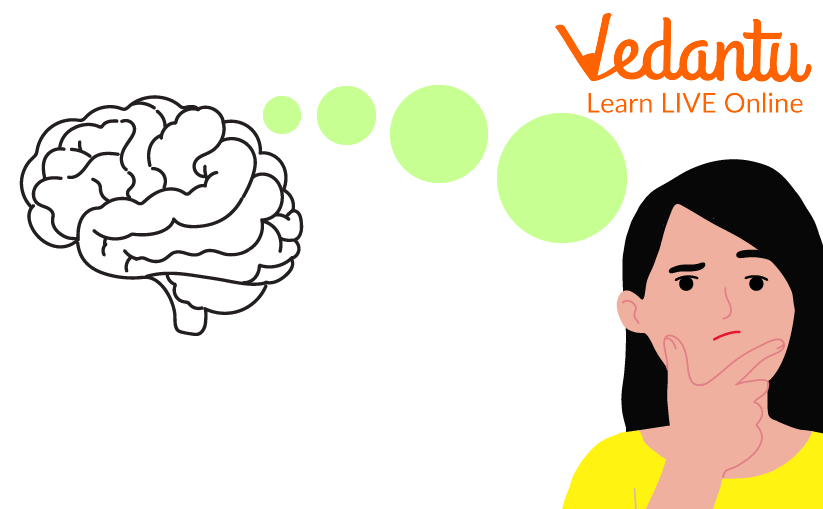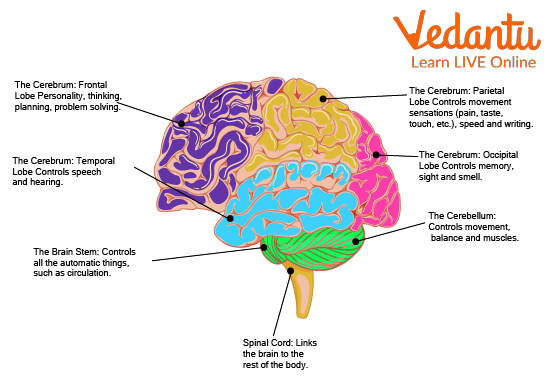




An Overview of Brain
The complex organ known as the brain regulates every bodily function, including cognition, memory, emotion, touch, motor skills, vision, respiration, temperature, and hunger. The central nervous system, or CNS, is made up of the spinal cord that emerges from the brain. The human brain, the pinnacle of biological evolution, supports thoughts, memory, movement, and emotions through a complex set of functions. It also serves as the nervous system's command centre. The major goal in pursuing health and longevity is to keep one's brain in good shape for the duration of one's life. In this article, we are going to discuss parts of the brain and how it communicates. There will be other information present in this article which you have to give a thorough read. So let's dive in and learn more about the brain stem.

Brain
Brain Stem Fun Facts
The human brain is composed of 60% fat. This makes the brain the fattest organ in the body, and these fatty acids are essential for the functioning of the brain. Make sure you're providing it with the right kind of nutritious, brain-enhancing food. Your brain hasn't fully matured by the time you're 25. The front of the brain develops first, with the back of the brain starting the process. Your frontal lobes, which govern reasoning and planning, are therefore the last to develop and organise connections.
Your brain has virtually infinite storage space for information. To control balance, breathing, heart rate, and other bodily functions, the brainstem communicates with the rest of your body. According to research, the human brain contains 86 billion neurons. One quadrillion (1,000 trillion) connection between neurons could be formed by each neuron. These neurons may merge over time, expanding the available storage. However, many neurons may suffer damage and cease to function in Alzheimer's disease, impacting memory in particular.
The remarkable speed at which brain information can move is 268 miles per hour. An electrical impulse is produced when a neuron is triggered and it moves from cell to cell. An epileptic seizure may result from an interruption in this usual processing.
Parts of Brain
The largest portion of the brain is the forebrain. The front of the brain is where it is situated. The parts of the frontal lobes are:
Cerebrum
Hypothalamus
Thalamus
Midbrain: The middle and smallest portion of the brain.
The midbrain is made up of:
Tectum
Tegmentum
Lower back of the brain, or hindbrain.
The parts of the hindbrain include:
Cerebellum
Medulla
Pons

Parts of Brain
Communication of Brain
A signal is delivered to your brain's sneeze centre when something enters your nose, such as bacteria, dust, or pollen. The sections of your body that must cooperate in order to assist you to sneeze receive signals from the sneeze centre. The sneeze centre signals your throat, eyes, and mouth to close tightly. While your throat muscles are relaxed, your chest muscles constrict and squeeze your lungs. All of it causes your nose and mouth to be forced to release air, saliva, and mucus.

Communication of Brain
Brain Stem Interesting Facts
Your brainstem is the stalk-like bottom portion of your brain. It links your spinal cord and brain. The brainstem communicates with the rest of your body in order to regulate balance, respiration, heart rate, and other basic functions. Your brainstem's functionality may be impacted by sudden trauma, heart or brain problems, or both. The basic processes of the brainstem include the control of breathing, eating, sleeping, and heart rate. It contributes to conduction as well. The brainstem is the necessary conduit for all signals travelling from the body to the cerebrum and cerebellum and vice versa.
Summary
To conclude all the conceptual understanding regarding the brain in this article, we can say that the mass of nerve tissue in an organism's head is known as the brain. The brain controls movement, integrates sensory information, and, in higher animals, is the centre of learning. The human brain weighs roughly 1.4 kg and contains billions of neurons (3 pounds). Since we have all the necessary facts about the brain, this information will help you in the further study of Biology. We hope you enjoyed reading this article, in case of any other doubts, feel free to ask in the comments.
FAQs on Brain Stem Fun Facts
1. Where exactly is the Brain?
The skull surrounds the brain and offers frontal, lateral, and dorsal protection. The 22 bones that make up the skull are divided into 8 cranial bones and 14 facial bones. Anatomically, the cerebrospinal fluid surrounds the brain, which is housed inside the skull. The Cerebrospinal Fluid (CSF), a fluid that fills the voids on the surface of the brain, flows inside the skull and spinal cord. Approximately 500 mL of CSF fluid is produced daily by the specialised ependymal cells.
The CSF's main job is to protect the brain from mechanical shocks and mild jolts by acting as a buffer. It also offers the brain some fundamental immunological defence. Additionally, CSF gives the brain buoyancy. In other words, the brain is suspended in a layer of CSF, where its weight is all but negated. The lower half of the brain's blood supply would be cut off if the brain were not suspended in CSF because of its weight. It would cause the neurons in the impacted area to die.
2. How does the brain function?
The brain functions like a powerful computer. It delivers messages back to the body after processing the data it gets from the senses and the body. However, the brain is considerably more powerful than a computer and is the source of human intellect. It enables us to feel, think, and act. The average human brain weighs about 1.5 kg and is about the size of two clenched fists. It has folds and crevices and resembles a giant walnut from the outside. About 100 billion nerve cells (neurons) make up brain tissue, along with a trillion supporting cells that keep the tissue stable.
3. How is blood pumped into the brain?
The brain requires an uninterrupted supply of sufficient oxygen, glucose, and other nutrients. It has an especially good blood supply as a result. Three arteries supply blood to the brain's two sides:
The tissue behind the forehead and beneath the crown is supplied by the anterior cerebral artery on the front (the top of the head). The sides and regions of the brain that are further within benefit from the middle cerebral artery. The internal carotid artery, a significant blood channel in the neck, splits into the anterior and middle cerebral arteries. The cerebellum, the lower portion of the brain, and the rear of the head are all supplied by the posterior cerebral artery. The vertebral arteries, which are also significant neck arteries, provide it with blood.









